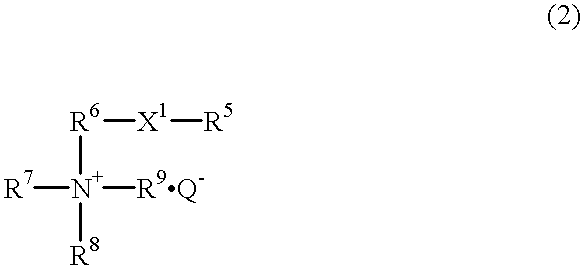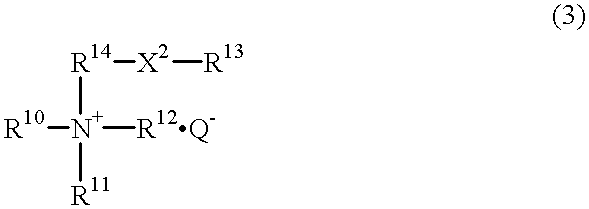Hair treatment composition
a technology for hair and composition, applied in the direction of detergent compositions, hair cosmetics, surface-active detergent compositions, etc., can solve the problems of poor emulsion stability, inability to emulsify, and inability to completely satisfy the biodegradability of quaternary ammonium salts,
- Summary
- Abstract
- Description
- Claims
- Application Information
AI Technical Summary
Problems solved by technology
Method used
Image
Examples
production example 2
An agitating type autoclave was charged with 353 g of behenyldimethylamine and 1,211 g of water, and 53 g of methyl chloride was blown into the resulting mixture with stirring over 3 hours while the reaction temperature was maintained at 80 to 90.degree. C., followed by 3 hours of maturation. The unreacted methyl chloride was then distilled off, and 169 g of sodium glutamate and 331 g of water were added, and salt exchange was effected at a treatment temperature of 80 to 90.degree. C. in a nitrogen atmosphere. Adjustment of the pH to 5 with citric acid gave the glutamic acid salt of the compound (a1) specified in Table 1 under (5).
production example 3
An agitating type autoclave was charged with 99 g of dimethyl carbonate, 353 g of behenyldimethylamine and 170 g of methanol, and the reaction was allowed to proceed with stirring at a reaction temperature of 110 to 130.degree. C. for 12 hours. Then, 133 g of aspartic acid was added, and salt exchange was effected while allowing the decarboxylation reaction to proceed at a reaction temperature of 60 to 80.degree. C. Thereafter, 1,542 g of water was added, and the methanol and unreacted dimethyl carbonate were removed in a nitrogen atmosphere at a temperature of 60 to 90.degree. C. and a pressure reduction degree of 100 mmHg. The subsequent adjustment of the pH to 5 with citric acid gave the aspartic acid salt of the compound (a1) specified in Table 1 under (5).
production example 4
An agitating type autoclave was charged with 99 g of dimethyl carbonate, 300 g of behenyldimethylamine, 45 g of stearyldimethylamine and 170 g of methanol, and the reaction was allowed to proceed with stirring at a reaction temperature of 110 to 130.degree. C. for 12 hours. Then, 147 g of glutamic acid was added, and the salt exchange reaction was effected while allowing the decarboxylation reaction to proceed at a temperature of 60 to 80.degree. C. Thereafter, 1,542 g of water was added and the methanol and unreacted dimethyl carbonate were removed in a nitrogen atmosphere at a temperature of 60 to 90.degree. C. and a pressure reduction degree of 100 mmHg. The subsequent adjustment of the pH to 5 with citric acid gave the glutamic acid salt of the compound (a1) specified in Table 1 under (11).
PUM
| Property | Measurement | Unit |
|---|---|---|
| Percent by mass | aaaaa | aaaaa |
| Percent by mass | aaaaa | aaaaa |
| Percent by mass | aaaaa | aaaaa |
Abstract
Description
Claims
Application Information
 Login to View More
Login to View More - R&D
- Intellectual Property
- Life Sciences
- Materials
- Tech Scout
- Unparalleled Data Quality
- Higher Quality Content
- 60% Fewer Hallucinations
Browse by: Latest US Patents, China's latest patents, Technical Efficacy Thesaurus, Application Domain, Technology Topic, Popular Technical Reports.
© 2025 PatSnap. All rights reserved.Legal|Privacy policy|Modern Slavery Act Transparency Statement|Sitemap|About US| Contact US: help@patsnap.com



